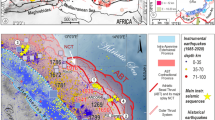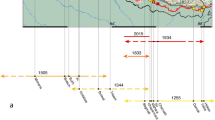Abstract
The Indo-Burman mountain ranges mark the boundary between the Indian and Eurasian plates, north of the Sumatra–Andaman subduction zone. Whether subduction still occurs along this subaerial section of the plate boundary, with 46 mm yr−1 of highly oblique motion, is contentious1,2,3,4,5,6,7,8. About 21 mm yr−1 of shear motion is taken up along the Sagaing Fault, on the eastern margin of the deformation zone8,9. It has been suggested that the remainder of the relative motion is taken up largely or entirely by horizontal strike-slip faulting and that subduction has stopped3,5,7,10. Here we present GPS measurements of plate motions in Bangladesh, combined with measurements from Myanmar9 and northeast India10, taking advantage of a more than 300 km subaerial accretionary prism spanning the Indo-Burman Ranges to the Ganges–Brahmaputra Delta11. They reveal 13–17 mm yr−1 of plate convergence on an active, shallowly dipping and locked megathrust fault. Most of the strike-slip motion occurs on a few steep faults, consistent with patterns of strain partitioning in subduction zones. Our results strongly suggest that subduction in this region is active, despite the highly oblique plate motion and thick sediments. We suggest that the presence of a locked megathrust plate boundary represents an underappreciated hazard in one of the most densely populated regions of the world.
This is a preview of subscription content, access via your institution
Access options
Subscribe to this journal
Receive 12 print issues and online access
$259.00 per year
only $21.58 per issue
Buy this article
- Purchase on Springer Link
- Instant access to full article PDF
Prices may be subject to local taxes which are calculated during checkout


Similar content being viewed by others
References
Nielsen, C., Chamot-Rooke, N., Rangin, C. & the ANDAMAN Cruise Team. From partial to full strain partitioning along the Indo-Burmese hyper-oblique subduction. Mar. Geol. 209, 303–327 (2004).
Le Dain, A. Y., Tapponnier, P. & Molnar, P. Active faulting and tectonics of Burma and surrounding regions. J. Geophys. Res. 89, 453–472 (1984).
Ni, J. F. et al. Accretionary tectonics of Burma and the three-dimensional geometry of the Burma subduction zone. Geology 17, 68–71 (1989).
Satyabala, S. P. Subduction in the Indo-Burma region: is it still active? Geophys. Res. Lett. 25, 3189–3192 (1998).
Rao, N. P. & Kumar, M. R. Evidences for cessation of Indian plate subduction in the Burmese arc region. Geophys. Res. Lett. 26, 3149–3152 (1999).
Guzman-Speciale, M. & Ni, J. F. Comment on “Subduction in the Indo-Burma region: is it still active?” by Satyabala, S. P. Geophys. Res. Lett. 27, 1065–1066 (2000).
Rangin, C., Maurin, T. & Masson, F. Combined effects of Eurasia/Sunda oblique convergence and East-Tibetan crustal flow on the active tectonics of Burma. J. Asian Earth Sci. 76, 185–194 (2013).
Vigny, C. et al. Present-day crustal deformation around Sagaing Fault, Myanmar. J. Geophys. Res. 108, 2533 (2003).
Maurin, T., Masson, F., Rangin, C., Min, U. T. & Collard, P. First global positioning system results in northern Myanmar: constant and localized slip rate along the Sagaing fault. Geology 38, 591–594 (2010).
Gahalaut, V. K. et al. Aseismic plate boundary in the Indo-Burmese wedge, northwest Sunda Arc. Geology 41, 235–238 (2013).
Steckler, M. S., Akhter, S. H. & Seeber, L. Collision of the Ganges Brahmaputra Delta with the Burma Arc: implications for earthquake hazard. Earth Planet. Sci. Lett. 273, 367–378 (2008).
Meng, J. et al. India–Asia collision was at 24° N and 50 Ma: palaeomagnetic proof from southernmost Asia. Sci. Rep. 2, 925 (2012).
Wang, Y., Sieh, K., Tun, S. T., Lai, K.-Y. & Myint, T. Active tectonics and earthquake potential of the Myanmar region. J. Geophys. Res. 119, 3767–3822 (2014).
Murphy, R. W. & staff of BOGMC Bangladesh enters the oil era. Oil Gas J. 86, 76–82 (1988).
Lindsay, J. F., Holliday, D. W. & Hulbert, A. G. Sequence stratigraphy and the evolution of the Ganges–Brahmaputra Delta complex. Am. Assoc. Petrol. Geol. Bull. 75, 1233–1254 (1991).
Curray, J. R. Geological history of the Bengal geosyncline. J. Assoc. Explor. Geophys. 12, 209–219 (1991).
Mitra, S., Bhattacharya, S. N. & Nath, S. K. Crustal structure of the western Bengal Basin from joint analysis of teleseismic receiver functions and Rayleigh-wave dispersion. Bull. Seismol. Soc. Am. 98, 2715–2723 (2008).
Johnson, S. Y. & Alam, A. M. N. Sedimentation and tectonics of the Sylhet trough, Bangladesh. Geol. Soc. Am. Bull. 103, 1513–1527 (1991).
Vernant, P. et al. Clockwise rotation of the Brahmaputra Valley relative to India: tectonic convergence in the eastern Himalaya, Naga Hills and Shillong Plateau. J. Geophys. Res. 119, 6558–6571 (2014).
Stork, A. L., Selby, N. D., Heyburn, R. & Searle, M. P. Accurate relative earthquake hypocenters reveal structure of the Burma subduction zone. Bull. Seismol. Soc. Am. 98, 2815–2827 (2008).
Dasgupta, S. & Nandy, D. R. Geological framework of the Indo–Burmese convergent margin with special reference to ophiolitic emplacement. Indian J. Geol. 67, 110–125 (1995).
Uddin, A. & Lundberg, N. Cenozoic history of the Himalayan-Bengal system: sand composition in the Bengal Basin, Bangladesh. Geol. Soc. Am. Bull. 110, 497–511 (1998).
Sikder, A. M. & Alam, M. M. 2-D modelling of the anticlinical structures and structural development of the eastern fold belt of the Bengal basin, Bangladesh. Sedim. Geol. 155, 209–226 (2003).
Williams, L. Late Quaternary Stratigraphy and Infilling of the Meghna River Valley Along the Tectonically Active Eastern Margin of the Ganges-Brahmaputra-Meghna Delta Master’s thesis, Vanderbilt Univ. Nashville (2014).
Socquet, A. et al. India and Sunda plates motion and deformation along their boundary in Myanmar determined by GPS. J. Geophys. Res. 111, B05406 (2006).
Maurin, T. & Rangin, C. Structure and kinematics of the Indo-Burmese Wedge: recent and fast growth of the outer wedge. Tectonics 28, TC2010 (2009).
Ruff, L. J. Do trench sediments affect great earthquake occurrence in subduction zones? Pure Appl. Geophys. 129, 263–282 (1989).
Oleskevich, D. A., Hyndman, R. D. & Wang, K. The updip and downdip limits to great subduction earthquakes: thermal and structural models of Cascadia, south Alaska, SW Japan, and Chile. J. Geophys. Res. 104, 14965–14991 (1999).
Heuret, A., Conrad, C. P., Funiciello, F., Lallemand, S. & Sandri, L. Relation between subduction megathrust earthquakes, trench sediment thickness and upper plate strain. Geophys. Res. Lett. 39, L05304 (2012).
Cummins, P. R. The potential for giant tsunamigenic earthquakes in the northern Bay of Bengal. Nature 449, 75–78 (2007).
Jarrard, R. D. Relations among subduction zone parameters. Rev. Geophys. 24, 217–284 (1986).
Herring, T. A., King, R. W. & McClusky, S. C. GAMIT Reference Manual, Release 10.4 (Massachusetts Institute of Technology Department of Earth, Atmospheric, and Planetary Sciences, 2010).
Herring, T. A., King, R. W. & McClusky, S. C. GLOBK Reference Manual, Global Kalman Filter VLBI and GPS Analysis Program, Release 10.4 (Massachusetts Institute of Technology Department of Earth, Atmospheric, and Planetary Sciences, 2010).
Altamimi, Z., Collilieux, X. & Métivier, L. ITRF2008: an improved solution of the International Terrestrial Reference Frame. J. Geod. 85, 457–473 (2011).
Mahesh, P. et al. Rigid Indian plate: constraints from GPS measurements. Gondwana Res. 22, 1068–1072 (2012).
Banerjee, P., Bürgmann, R., Nagarajan, B. & Apel, E. Intraplate deformation of the Indian subcontinent. Geophys. Res. Lett. 35, L18301 (2008).
Jade, S. et al. Estimates of interseismic deformation in Northeast India from GPS measurements. Earth Planet. Sci. Lett. 263, 221–234 (2007).
Bettinelli, P. et al. Plate motion of India and interseismic strain in the Nepal Himalaya from GPS and DORIS measurements. J. Geod. 80, 567–589 (2006).
Okada, Y. Internal deformation due to shear and tensile faults in a half-space. Bull. Seismol. Soc. Am. 82, 1018–1040 (1992).
Feng, L. et al. Active deformation near the Nicoya Peninsula, Northwestern Costa Rica, between 1996 and 2010: interseismic megathrust coupling. J. Geophys. Res. 117, B06407 (2012).
Wang, K. & Dixon, T. “Coupling” semantics and science in earthquake research. Eos Trans. AGU 85, 180–181 (2004).
Acknowledgements
We thank R. Bürgmann for comments that helped to improve the paper. We thank J. Armbruster, who installed the initial 6 stations in 2003, and N. Feldl, who helped install 12 stations in 2007. We also thank the Dhaka University students who helped maintain the GPS network and the people at the many sites that host the GPS stations. Without their efforts and UNAVCO support, this project would not have been possible. We thank M. Kogan for help with processing. We thank C. Rangin, F. Masson and T. Maurin for sharing their Myanmar GPS data with us. This material is based on equipment and engineering services provided by the UNAVCO Facility with support from the National Science Foundation (NSF) and National Aeronautics and Space Administration (NASA) under NSF Cooperative Agreement EAR-0735156. This project was supported by NSF INT 99-00487, NSF EAR-06 36037 and NSF IIA 09-68354. L.F. and E.M.H. were supported by Singapore National Research Foundation Fellowship number NRF-NRFF2010-064. Lamont-Doherty Earth Observatory publication number 8204.
Author information
Authors and Affiliations
Contributions
M.S.S. planned the paper. D.R.M. did the model analysis with assistance from L.F. and E.M.H., while S.H.A. processed the GPS data. J.G. and M.H. contributed to the data projections. M.S.S., S.H.A., D.R.M. and L.S. installed and maintained the GPS network. All authors discussed the results and contributed to writing the manuscript.
Corresponding author
Ethics declarations
Competing interests
The authors declare no competing financial interests.
Supplementary information
Supplementary Information
Supplementary Information (PDF 1004 kb)
Supplementary Information
Supplementary Information (XLSX 54 kb)
Supplementary Information
Supplementary Information (XLSX 51 kb)
Rights and permissions
About this article
Cite this article
Steckler, M., Mondal, D., Akhter, S. et al. Locked and loading megathrust linked to active subduction beneath the Indo-Burman Ranges. Nature Geosci 9, 615–618 (2016). https://doi.org/10.1038/ngeo2760
Received:
Accepted:
Published:
Issue Date:
DOI: https://doi.org/10.1038/ngeo2760
This article is cited by
-
Unfolding rotational tectonics and topographic evolution from localized verses diffuse plate boundary counterparts
Scientific Reports (2024)
-
FRS (Fault Rating System): a quantitative classification of active faults for hazard evaluations
International Journal of Earth Sciences (2024)
-
Earthquake preparedness in an urban area: the case of Dhaka city, Bangladesh
Geoscience Letters (2023)
-
Three-dimensional kinematics of the India–Eurasia collision
Communications Earth & Environment (2023)
-
High-resolution lithostratigraphy and reconnaissance sedimentology of Changotaung structure, Chittagong Tripura fold belt, Bengal Basin, Bangladesh
Scientific Reports (2023)



